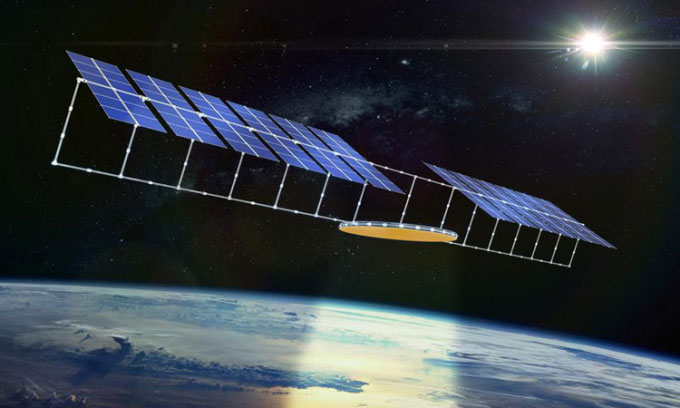How does a solar power station in outer space work?
Cosmic solar power consists of collecting solar energy in space and transmitting it back to Earth. The idea isn't new, but recent technological advances have made it even more possible, says Jovana Radulovic, head of the Department of Mechanical Engineering and Design Engineering at the University of Portsmouth (UK).

Simulation of solar panels operating in space. (Photo: NASA).
The space solar power system requires a giant spacecraft equipped with many solar panels. They will produce electricity, then transmit it wirelessly back to Earth via high-frequency radio waves. A ground antenna, called a rectenna, converts radio waves into electricity and feeds it back into the grid.
The solar power station in orbit is illuminated by the sun 24 hours a day, so it can produce electricity continuously. This is an advantage over sub-Earth systems, which only produce electricity during the day and are weather dependent. With world energy demand expected to grow by nearly 50% by 2050, space solar could be the key to helping meet growing electricity demand and tackle rising global temperatures, Radulovic said. determined.
However, the construction of the space solar power station also faces many challenges. Stations are usually modular in design and require robots to be assembled in orbit. Putting both the robot and the module into space is extremely difficult, expensive and can be harmful to the environment.
Initially, the weight of the solar panels was also an issue. But this has been solved thanks to the development of ultralight energy cells (a solar panel made up of many small cells).
Space solar power is now considered technically feasible mainly due to advances in technology such as lightweight batteries, wireless power transmission and space robotics. However, assembling even a single space solar power station will require multiple launches. While the station is built with the goal of reducing carbon emissions in the long term, such launches are both high emissions and expensive. The development of reusable rockets by companies like Space X could help reduce the cost of building solar power stations in space.
After successful construction, the space solar power station still faces many other challenges. The panels can be damaged by space junk. They are also not protected by Earth's atmosphere and are exposed to intense solar radiation, which means they will degrade faster than solar cells on Earth, reducing the amount of electricity they produce.
The efficiency of wireless power transmission is also an issue. Transferring energy over great distances, in this case from spacecraft to the ground, is no easy feat. With current technology, only a fraction of the collected solar energy will reach the Earth.
Despite the above challenges, experts are still researching and implementing a number of space solar power projects. The Space Solar Projects Group in the US is developing high-performance solar cells as well as a conversion and transmission system optimized for space use. The US Navy Research Laboratory tested a solar module and power conversion system in space in 2020. Meanwhile, China announced plans to build the Bishan space solar power station with the goal of operational in 2035.
In the UK, experts are considering a £17 billion space solar power development project. The project will start with small tests, then progress to building a solar power station that will be operational by 2040. The station is expected to have a diameter of 1.7 km and a weight of about 2,000 tons. An antenna under the ground will be huge, about 6.7 km x 13 km, most likely located at sea. The station is expected to provide 2GW of electricity to the UK.
- China's ambition to build a 1MW solar power station in space
- Power transmission without wires
- China built a huge energy station in the universe
- The environment in outer space may not affect reproduction
- Trip outside the 200th space on the International Space Station
- Why are astronauts forbidden to drink in outer space?
- China aspires to build the first solar power plant in space
- Russian space station will replace the US ISS global surveillance
- Unique power plant shaped wine glasses
- International Space Station
- Collecting solar power from the universe to the earth
- How do astronauts sleep in space?
 Norway built the world's tallest wooden tower
Norway built the world's tallest wooden tower Kremlin
Kremlin Ashurbanipal: The oldest royal library in the world
Ashurbanipal: The oldest royal library in the world Decoding the thousand-year construction of Qin Shihuang shocked the world
Decoding the thousand-year construction of Qin Shihuang shocked the world